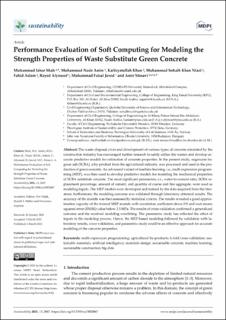| dc.description.abstract | The waste disposal crisis and development of various types of concrete simulated by the construction industry has encouraged further research to safely utilize the wastes and develop accurate predictive models for estimation of concrete properties. In the present study, sugarcane bagasse ash (SCBA), a by-product from the agricultural industry, was processed and used in the production of green concrete. An advanced variant of machine learning, i.e., multi expression programming (MEP), was then used to develop predictive models for modeling the mechanical properties of SCBA substitute concrete. The most significant parameters, i.e., water-to-cement ratio, SCBA replacement percentage, amount of cement, and quantity of coarse and fine aggregate, were used as modeling inputs. The MEP models were developed and trained by the data acquired from the literature; furthermore, the modeling outcome was validated through laboratory obtained results. The accuracy of the models was then assessed by statistical criteria. The results revealed a good approximation capacity of the trained MEP models with correlation coefficient above 0.9 and root means squared error (RMSE) value below 3.5 MPa. The results of cross-validation confirmed a generalized outcome and the resolved modeling overfitting. The parametric study has reflected the effect of inputs in the modeling process. Hence, the MEP-based modeling followed by validation with laboratory results, cross-validation, and parametric study could be an effective approach for accurate modeling of the concrete properties. | en_US |

